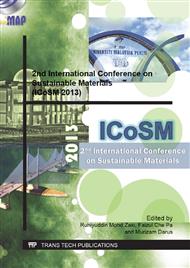p.304
p.308
p.313
p.318
p.324
p.329
p.334
p.338
p.343
Effect pf Thermoplastic Polymer Waste (PET) in Lightweight Concrete
Abstract:
Contruction concrete that use of insulation wall in building construction faces some problems such as having high weight, very reflective sound, heat transfer (the effectiveness of heat conductivity) incompetence and mechanical properties (strength) constraints. The sounds which impinge the wall cannot be absorbed efficiently but instead gives high reflection. This causes some noise of high echo in a room. So a good acoustic insulation must be efficient in absorbing the sound. This project proposes lightweight concrete as a replacement for insulation wall. This lightweight concrete will be developed using thermoplastic polymer waste which is recycled plastic bottles, sand, water, and cement. This research used thermoplastic polymer waste which is PET (Polyethylene Terephthalate) material as the reinforcement material to replace small gravel in lightweight concrete. All its composition percentage of raw materials was divided into different samples composition. Its composition determines the performances of the samples in density, porosity and mechanical properties.
Info:
Periodical:
Pages:
324-328
Citation:
Online since:
September 2013
Authors:
Keywords:
Price:
Сopyright:
© 2013 Trans Tech Publications Ltd. All Rights Reserved
Share:
Citation:


